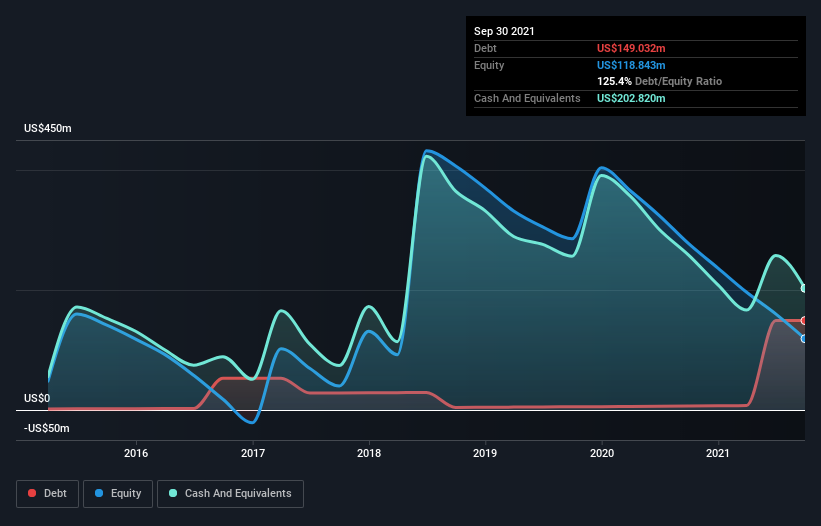- United States
- /
- Biotech
- /
- NasdaqCM:HRTX
Health Check: How Prudently Does Heron Therapeutics (NASDAQ:HRTX) Use Debt?

Warren Buffett famously said, 'Volatility is far from synonymous with risk.' It's only natural to consider a company's balance sheet when you examine how risky it is, since debt is often involved when a business collapses. As with many other companies Heron Therapeutics, Inc. (NASDAQ:HRTX) makes use of debt. But the real question is whether this debt is making the company risky.
When Is Debt A Problem?
Generally speaking, debt only becomes a real problem when a company can't easily pay it off, either by raising capital or with its own cash flow. If things get really bad, the lenders can take control of the business. However, a more usual (but still expensive) situation is where a company must dilute shareholders at a cheap share price simply to get debt under control. Of course, plenty of companies use debt to fund growth, without any negative consequences. The first step when considering a company's debt levels is to consider its cash and debt together.
View our latest analysis for Heron Therapeutics
How Much Debt Does Heron Therapeutics Carry?
As you can see below, at the end of September 2021, Heron Therapeutics had US$149.0m of debt, up from US$6.64m a year ago. Click the image for more detail. But it also has US$202.8m in cash to offset that, meaning it has US$53.8m net cash.

How Strong Is Heron Therapeutics' Balance Sheet?
We can see from the most recent balance sheet that Heron Therapeutics had liabilities of US$72.3m falling due within a year, and liabilities of US$161.2m due beyond that. On the other hand, it had cash of US$202.8m and US$43.1m worth of receivables due within a year. So it can boast US$12.4m more liquid assets than total liabilities.
Having regard to Heron Therapeutics' size, it seems that its liquid assets are well balanced with its total liabilities. So while it's hard to imagine that the US$829.8m company is struggling for cash, we still think it's worth monitoring its balance sheet. Simply put, the fact that Heron Therapeutics has more cash than debt is arguably a good indication that it can manage its debt safely. There's no doubt that we learn most about debt from the balance sheet. But it is future earnings, more than anything, that will determine Heron Therapeutics's ability to maintain a healthy balance sheet going forward. So if you're focused on the future you can check out this free report showing analyst profit forecasts.
Over 12 months, Heron Therapeutics made a loss at the EBIT level, and saw its revenue drop to US$86m, which is a fall of 16%. That's not what we would hope to see.
So How Risky Is Heron Therapeutics?
We have no doubt that loss making companies are, in general, riskier than profitable ones. And in the last year Heron Therapeutics had an earnings before interest and tax (EBIT) loss, truth be told. And over the same period it saw negative free cash outflow of US$216m and booked a US$228m accounting loss. While this does make the company a bit risky, it's important to remember it has net cash of US$53.8m. That means it could keep spending at its current rate for more than two years. Even though its balance sheet seems sufficiently liquid, debt always makes us a little nervous if a company doesn't produce free cash flow regularly. When analysing debt levels, the balance sheet is the obvious place to start. However, not all investment risk resides within the balance sheet - far from it. Be aware that Heron Therapeutics is showing 4 warning signs in our investment analysis , you should know about...
When all is said and done, sometimes its easier to focus on companies that don't even need debt. Readers can access a list of growth stocks with zero net debt 100% free, right now.
Valuation is complex, but we're here to simplify it.
Discover if Heron Therapeutics might be undervalued or overvalued with our detailed analysis, featuring fair value estimates, potential risks, dividends, insider trades, and its financial condition.
Access Free AnalysisHave feedback on this article? Concerned about the content? Get in touch with us directly. Alternatively, email editorial-team (at) simplywallst.com.
This article by Simply Wall St is general in nature. We provide commentary based on historical data and analyst forecasts only using an unbiased methodology and our articles are not intended to be financial advice. It does not constitute a recommendation to buy or sell any stock, and does not take account of your objectives, or your financial situation. We aim to bring you long-term focused analysis driven by fundamental data. Note that our analysis may not factor in the latest price-sensitive company announcements or qualitative material. Simply Wall St has no position in any stocks mentioned.
About NasdaqCM:HRTX
Heron Therapeutics
A commercial-stage biotechnology company, focuses on enhancing the lives of patients by developing and commercializing therapeutic that enhances medical care.
Undervalued with reasonable growth potential.
Similar Companies
Market Insights
Community Narratives




